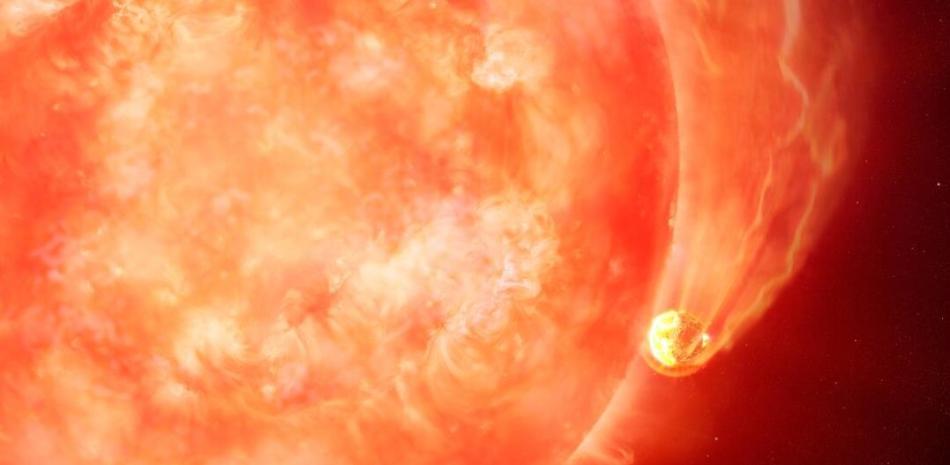According to a study published in the journal ‘Nature’, astronomers have observed for the first time how a star can swallow a planet, which could affect Earth within 5,000 million years.
When a star runs out of fuel, it swells to a million times its original size and finds any object in its path, including planets. Scientists have observed hints of stars before, and shortly after, consuming entire planets, but they haven’t caught one in action yet.
In the study, scientists from the Massachusetts Institute of Technology (MIT), Harvard University, Caltech and other centers in the US report that for the first time they have observed a star engulfing a planet.
The planetary extinction appears to have taken place in our own galaxy, about 12,000 light-years away, near the constellation Aquila. There, astronomers witnessed a starburst that grew 100 times brighter in just 10 days, before quickly fading away.
Interestingly, this flash of white light was followed by a long lasting, cool signal. The scientists concluded that this combination could only be due to one event: a star engulfing a nearby planet.
“We were looking at the final phase of the sink,” said lead author Kishale Di, a postdoctoral researcher at MIT’s Kavli Institute for Astrophysics and Space Research.
Scientists estimate that the vanished planet was probably a hot Jupiter-sized world that was spinning, swept away by the dying star’s atmosphere and eventually its core.
Earth will suffer the same fate when the Sun is expected to burn up the inner planets of the Solar System, albeit not for another 5 billion years.
“We’re looking at the future of Earth,” Dee says. “If some other civilization was watching us from 10,000 light-years away as the Sun engulfed the Earth, they would see the Sun suddenly ejecting some material, then ejecting patterns. Before returning, dust around it”.
The team discovered the eruption in May 2020. However, it took another year for astronomers to find an explanation for what it could be.
The initial signal was found in a search of data taken by the Zwicky Transient Facility (ZTF) at Caltech’s Palomar Laboratory in California. The ZTF is an observatory that scans the sky for stars that rapidly change in brightness, indicating the presence of supernovae, gamma-ray bursts, and other stellar events.
D was looking at the ZTF data for signs of flares in binary stars, systems where two stars orbit each other, where one often pulls mass away from the other and briefly brightens as a result.
“One night, out of nowhere, I saw a star that had brightened by a factor of 100 in a week,” Dee recalled.
Hoping to determine the source with more data, Dee turned to observations of the same star made by the Keck Observatory in Hawaii. Keck telescopes make spectroscopic measurements of starlight, which scientists can use to determine a star’s chemical composition.
But what he found confused him even more. While most binary stars yield stellar material such as hydrogen and helium, when one star corrodes another, the new source yields none of that. Instead, Dee saw signs of “strange molecules” that exist only at very cold temperatures.
“These molecules are only found in very cool stars,” Di says. “When a star is glowing, it’s generally heating up. So, low temperature and stellar brightness don’t go hand in hand.”
It later became clear that the signal was not from a stellar binary. I decided to wait for more answers to come out. About a year after its initial discovery, he and his colleagues analyzed observations of the same star, this time taken with an infrared camera at the Palomar Observatory. In the infrared band, in contrast to the white-hot optical emissions arising from binaries and other extreme stellar events, astronomers can see signs of cooler objects.
“That infrared data made me fall out of my chair,” Dee recalled. The source was incredibly bright in the near-infrared.”
Apparently, after its initial hot flash, the star continued to emit cool energy for the next year. That icy material may be gas from the star that has blown off into space and condensed into dust, cool enough to be detected at infrared wavelengths. These data suggest that the star may merge with another rather than shine as a result of a supernova explosion.
But when the team analyzed the data further and combined it with measurements made by NEOWISE, NASA’s infrared space telescope, they came to a more interesting conclusion. From the data collected, they calculated the total amount of energy released by the star since its initial explosion, and found that it was surprisingly small: about 1/1,000 the size of a stellar merger observed in the past.
“That means everything connected to the star must be 1,000 times smaller than any other star we’ve seen,” Dee said. “It’s a happy coincidence that Jupiter’s mass is 1/1,000 that of Earth.” “The Sun is the only time we realize: it’s a planet that’s crashed into its star.”
With the pieces in place, scientists were finally able to explain the initial explosion. The bright, hot flash could be the final moment of a Jupiter-sized planet being swept away by the dying star’s atmosphere. As the planet fell into the star’s core, the star’s outer layers fell off and settled as cool dust over the next year.
“For decades we’ve been able to see back and forth,” Di points out. “Before, when the planets are still orbiting very close to their star, and then, when a planet is already engulfed and the star is massive. What. When a planet experiences this fate in real time, we don’t see the star being actively captured. That’s what makes this discovery so exciting.”





